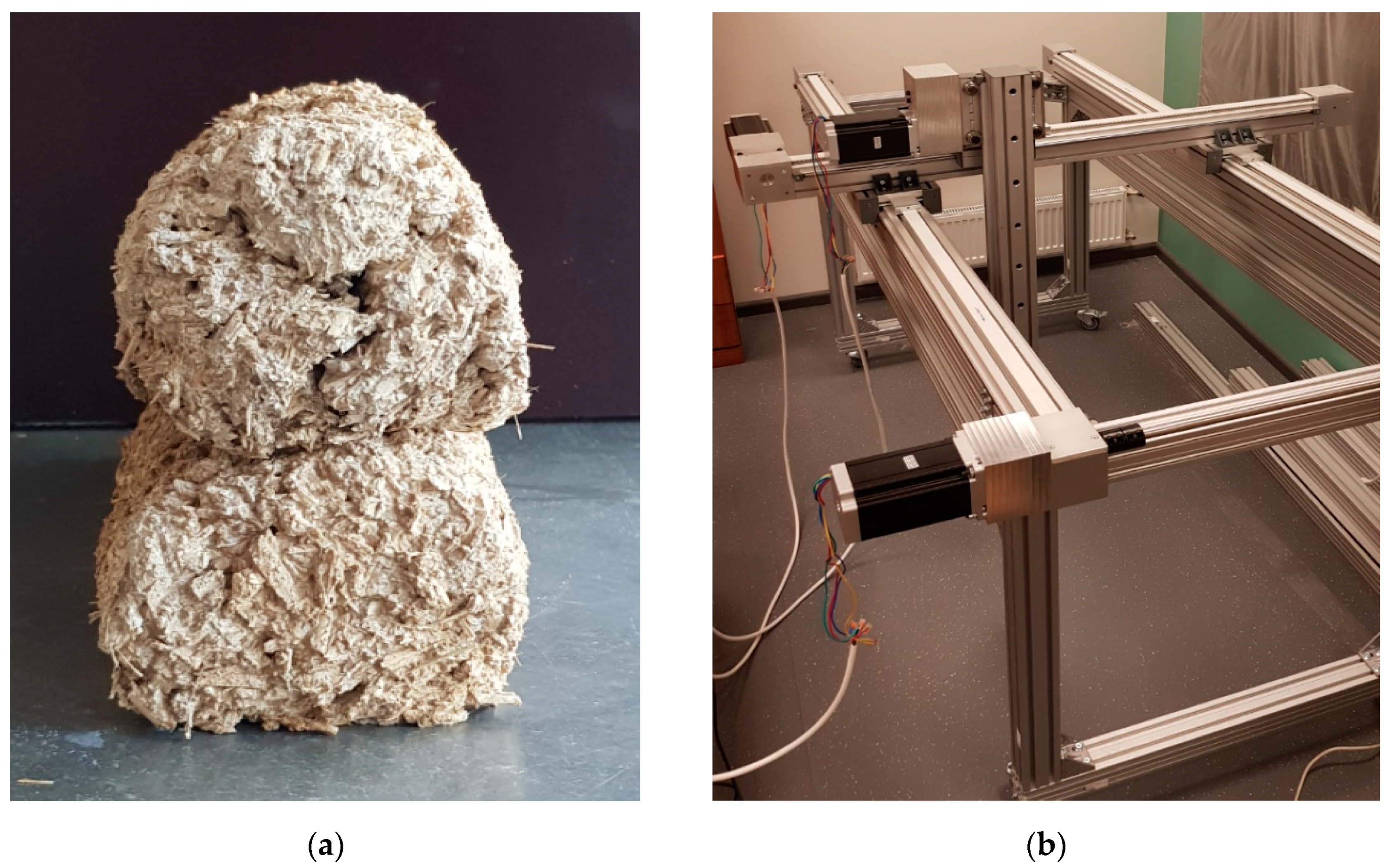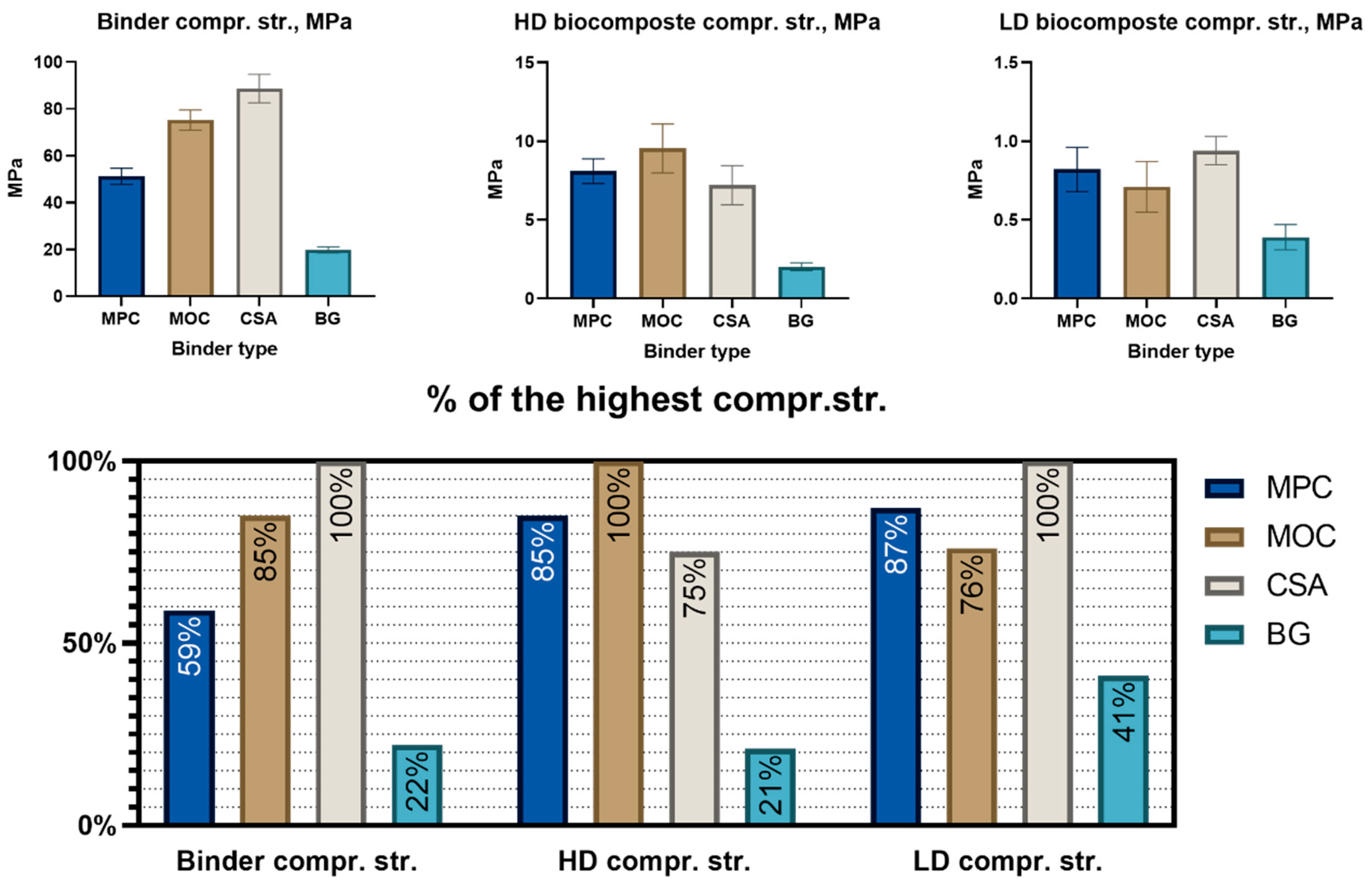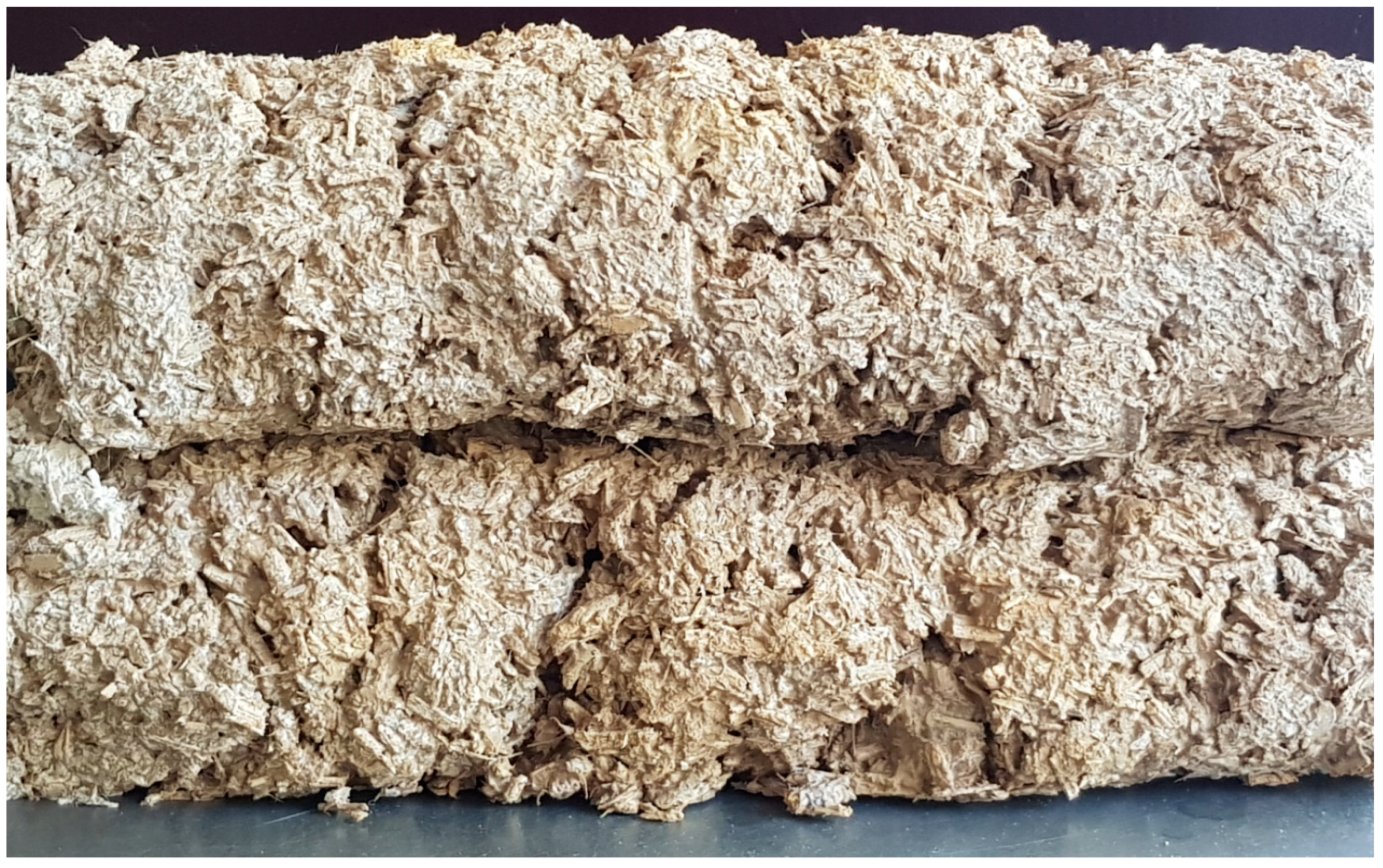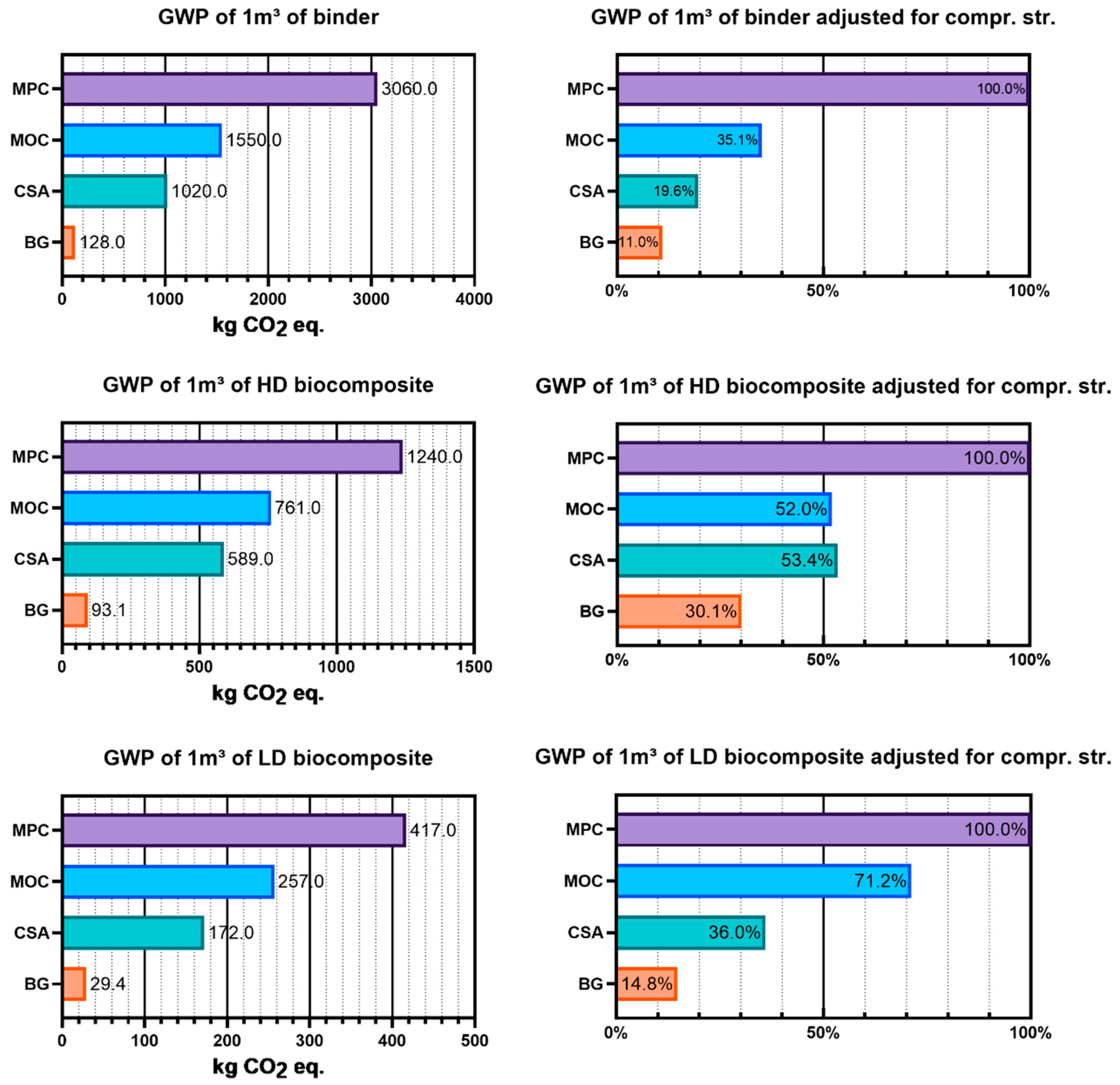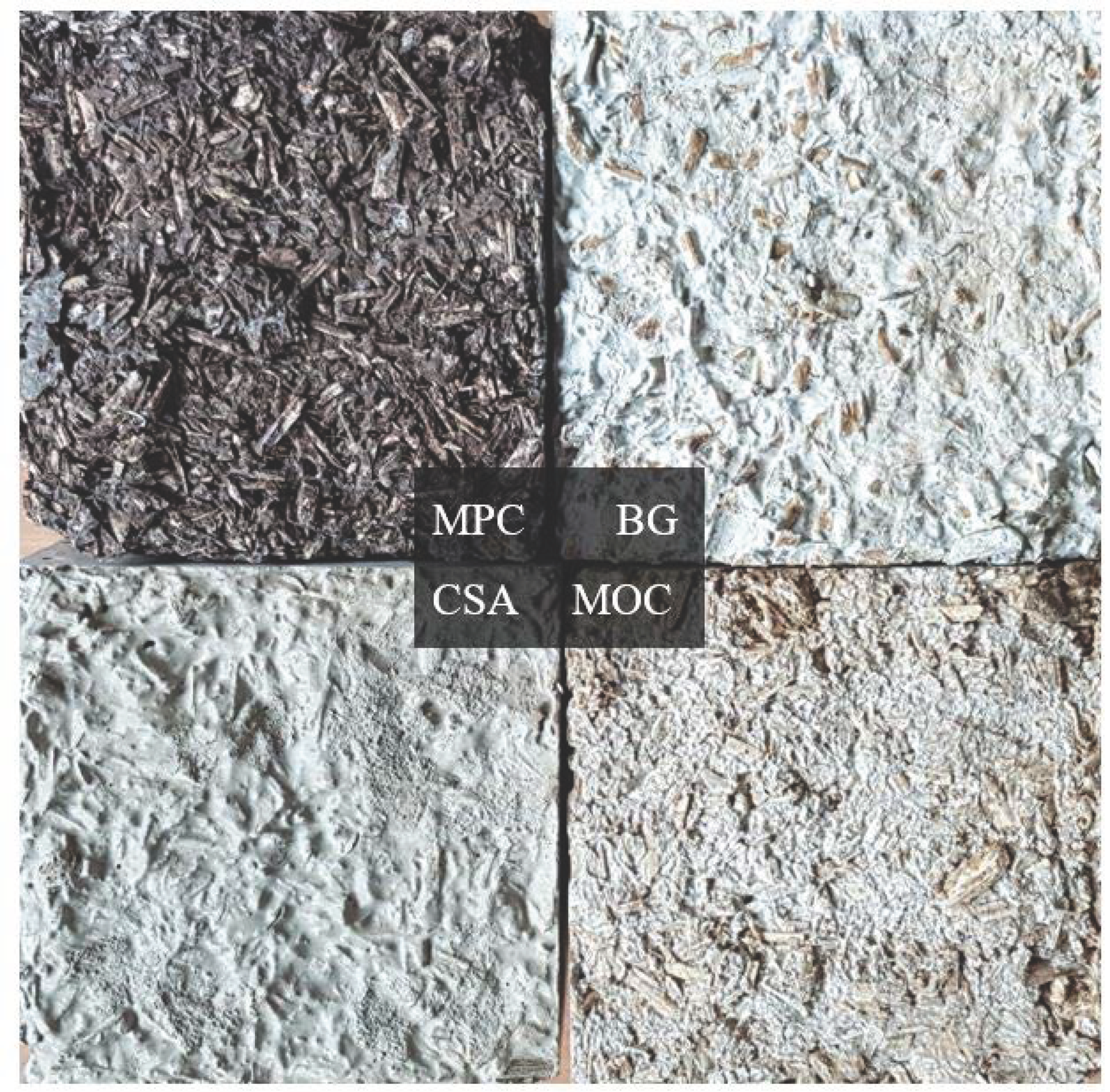1. Introduction
In recent years, world leaders have signed several agreements committing to limit CO
2 emissions, for example the Paris Agreement ratified by the EU in 2016 [
1]. In order to achieve these commitments, the EU has several environmental targets—for example the Energy and Climate framework 2030 aiming to reduce the greenhouse gases by 40% and increase energy efficiency by 32% by 2030 [
2], or the 2050 long-term strategy that aims for climate-neutrality by 2050 [
3]. However, these efforts do not contribute significantly to reducing the global CO
2 level, as it is still on the rise and has exceeded 410 ppm, moving closer to 450 ppm, which is viewed as a boarder to keep global temperature rise under 2 °C. Therefore, additional efforts are necessary to achieve the goals set by world leaders.
The construction industry is one of the largest emitters of CO
2 [
4] and also contributes negatively to other environmental impact categories [
5] mainly because the production of traditional building materials is highly energy intensive and uses considerable amounts of raw materials. The construction industry needs to become more sustainable due to the diminishing natural resources and increasing CO
2 emissions resulting from the production of building materials. The increasing demand for building materials has called for an alternative and resource-saving production and raw material sourcing method.
One group of such low impact materials are bio-based building materials. These materials use agricultural or wooden waste products as a primary filler together with mineral binder—lime, magnesium, gypsum, geopolymers, etc. [
6]. Due to the organic source of the filler, these materials can be carbon neutral or even negative [
7,
8].
Regarding resource-saving production, 3D printing technologies are becoming more widespread and available; their use in construction industry is rapidly advancing and has gone from prototyping to fully printed houses in a few years [
9]. The European Commission recognizes that 3D printing would lower CO
2 emissions due to reduction of transport and material use and could bring industrial transformation, thus has made it one of its priority areas of technology, e.g., by funding more than 20 projects based on 3D printing Horizon 2020 between 2014 and 2016 [
10].
Thus, combination of both—bio-based building materials and 3D printing—could bring the necessary changes to reduce the environmental impact of the construction industry and to lower overall CO2 emissions to achieve targets set by the global community.
Traditional binders used in bio-based materials (lime and hydraulic lime) exhibit relatively low strength and no early setting; thus, they are not functional for 3D printing [
11]. OPC-based binders that are usually used for 3D printing have high early strength but have problems related to their sustainability [
12] and compatibility with some bio-based fillers [
13]. Thus, three different types of binders will be explored in this research for their possible applications in 3D printing with bio-based fillers.
The first group to be explored is magnesium-based binders (magnesium oxychloride cement (MOC) and magnesium phosphate cement (MPC)) that have been shown to have good compatibility with bio-based fillers and high early strength [
14,
15] but have not been extensively used for 3D printing previously. The second group is calcium sulfoaluminate (CSA) cements, which have been used for 3D printing applications due to their fast setting [
16] but have not been studied comprehensively. These cements have a lower CO
2 footprint than OPC [
17]. The third group is gypsum-based binders that can be produced from either raw sources of gypsum or waste products, such as flue gas desulphurisation gypsum or phosphogypsum [
18]. These are fast-setting binders that are used in 3D printing applications but mostly in powder-based ink-jet printing [
19]. Gypsum binders have durability issues in the water presence, but these can be addressed using a gypsum-cement–pozzolan mix. These binders have also been successfully used together with bio-based fillers [
20]. Thus, these three binder types will be studied for possible applications in 3D printing with bio-based fillers.
In this study, the setting time and compressive strength of the selected binders will be determined to evaluate their applicability for 3D printing. Using these binders, biocomposites of different densities will be made with hemp shives filler: high-density (HD—around 1000 kg/m
3) biocomposites for load-bearing applications and low-density (LD—around 400 kg/m
3) biocomposites for thermal insulation or permanent formwork applications. Biocomposites will be moulded and tested to determine their properties. Following this, a custom-built screw extruder will be used to test the extrudability and buildability of the biocomposites (
Figure 1a). This research is part of a research project that will use a custom-built gantry printer in the later stages for printing the biocomposites (
Figure 1b).
As mentioned above, the selected binders should also provide a reduced environmental impact to meet contemporary requirements. As this study will not look for optimized solutions using 3D printing, but only search for suitable binders that could be used in 3D printing together with bio-based filler, then the environmental impact will also be considered in the context of the binder. Therefore, the selected binders will be preliminarily considered using LCA to determine the Global Warming Potential (GWP), expressed in CO2 equivalents, generated during the binder production process.
2. Materials and Methods
Two types of magnesium-based binders were used. Magnesium oxychloride cement (MOC) was produced by combining caustic magnesia and magnesium chloride salt solution (1:1 salt:water by weight). Caustic magnesia RKMH-F was produced by RHI AG Ltd. (Austria), with MgO amount of at least 73% according to information from producer (
Table 1). Magnesium chloride hexahydrate containing 47% MgCl
2 (produced in Germany) was used. The magnesium phosphate cement (MPC) used in this study is based on a monopotassium phosphate reaction with dead-burnt magnesium oxide. The dead-burnt magnesium oxide M-76 was produced by Integra Ltd. (Slovakia) with MgO amount of at least 81%. Monopotassium phosphate KH
2PO
4 produced by Prayon S.A. Ltd. was used, with a P
2O
5 content of at least 51.6%.
For CSA cement, a binder from Buzzi Unicem (Italy)—NEXT BASE—was used. It is formulated using NEXT CLINKER and anhydride; NEXT CLINKER is a sulfoaluminate clinker made from bauxite, gypsum and limestone calcined at 1350 °C (
Table 1). As the calcination temperatures for the main ingredients are lower than that of cement and raw materials used contain fewer carbonates, NEXT BASE has significantly lower CO
2 emissions than ordinary Portland cement (689 kg/t vs. 913 kg/t for OPC) [
21]. For gypsum binder (BG), a Knauf BAUGIPS (Latvia) hemihydrate was used with chemical composition determined in previous study—seen in
Table 1 [
22].
Hemp shives provided by Zalers Ltd. (Latvia) were used as bio-based fillers. The bulk density of the shives was 81 kg/m3, water absorption at 4-h immersion was 400%, and the size range was 2–25 mm, with 67% of the particles being at the range of 5–15 mm.
Binder compositions are shown in
Table 2. The optimal ratios of MgO/MgCl
2 and MgO/KH
2PO
4 have been determined in previous studies [
8]. The W/B ratio was chosen to ensure the same workability for all binders—240–260 mm flow diameter determined with flow table according to EN 459-2; in the case of MOC the MgCl
2 was premixed with the water to make 1:1 brine solution. The setting time was determined using a Vicat apparatus. Samples with sizes 20 × 20 × 20 mm were molded in polyurethane molds. Fresh binder density was determined according to EN 1015-6, for hardened binder—by weighting and measuring dried samples. Samples were demolded after 20 h, BG samples were kept in laboratory curing conditions (20 ± 2 °C and 50 ± 10% RH) until testing, MPC, MOC and CSA samples were kept in a plastic container bags for the first six days to prevent the samples from drying too fast and afterwards the samples were kept in the same laboratory curing conditions as BG samples. Compressive strength was tested on days 1, 7 and 28 on a ZWICK Z100 universal testing machine.
Biocomposites were produced using bio-based filler (hemp shives) and the tested binders. Before mixing, hemp shives were premixed with water of the same weight to prevent hemp shives from absorbing the water necessary for binders. W/B ratio is used the same as in binder tests. Biocomposite density was adjusted by altering the filler/binder ratio, HD with designed density around 1000 kg/m
3 and LD with designed density around 400 kg/m
3 (as seen in
Table 3). Biocomposites were molded in steel and plywood molds, tamped manually to achieve similar density as when using the custom-built extruder. Fresh biocomposite density was determined by weighting the biocomposite amount in the mood, for hardened biocomposites—by weighting and measuring dried samples. 100 × 100 × 100 mm samples for compressive strength were tested perpendicular to tamping direction on ZWICK Z100 at 28 days of curing. Biocomposite samples were demolded after 24 h and kept in laboratory curing conditions (20 ± 2 °C and 50 ± 10% RH) until testing. Then, 350 × 350 × 100 mm samples were used for thermal conductivity tests according to EN 12667 on FOX600 apparatus.
Following this, biocomposite extrudability was tested with a custom-made screw extruder, made of a conveyor screw, 18V motor with 40 Nm torque, and a polypropylene pipe extruder body and a nozzle that forms a narrowing from 100 to 85 mm. The design was inspired by a print-head from lightweight concrete and wood chip printing research [
23]. Buildability and extrudability tests were adopted and customized from printable fiber-reinforced concrete research [
24], both are qualitative methods. Extrusion is defined as acceptable by two successive layers at least 350 mm long with a diameter 80 mm without obstruction, such as nozzle blockage, significant tearing or buckling. Buildability is defined successful if two successive layers of fresh mixtures with the same dimensions are built-up layer upon layer without layer failure or excessive deformations. Extrusion is done by moving the extruder horizontally at a constant speed and raising it manually to print two consecutive layers on top of each other with no delay time between the layers. Extruded mixtures are identical to mold-casted mixtures (
Table 3). As the mixtures are placed manually in the extruder, pumpability is not investigated in this research.
Preliminary LCA—Definition of Goal and Scope and Inventory Analysis
LCA was used in this study to preliminary evaluate the environmental impact of the fast setting binders considered in this study for the 3D printing of bio-composites, as the environmental impact of selected binders has rarely been studied. In this study, all binders were assessed and compared between themselves, as a reference value the environmental impact of Portland cement mentioned above was used. As this is a preliminary study, “cradle-to-gate” system boundaries were used to take into account only the production process of the binders. Impact assessment is carried out using the IPCC 2013 GWP100a method, which calculates global warming potential and expresses it in CO2 equivalents. The SimaPro 8 LCA software was used to perform the calculations.
Three different functional units were defined—1 m
3 of binder, 1 m
3 of HD biocomposite and 1 m
3 of LD biocomposite. Since the main task is to compare binders with each other, the bio-based filler is not taken into account in these calculations, only the binder is. To prepare HD and LD biocomposites, the binder ratio was taken from
Table 3, which shows the compositions of the biocomposites and multiplied by 100. To produce 1 m
3 of binder, the amount of raw materials required was determined experimentally and it is as follows: MPC—1979.9 kg, MOC—1627.6 kg, CSA—1477.3 kg and BG—1306.9 kg of the raw binder.
The Ecoinvent 3 database is used for most processes, such as the BG binder. The processes of MOC and MPC binders have been described in previous studies [
8]. For CSA binder a new process has been created adapting the cement production process and adjusting the CO
2 emissions according to the environmental product declaration from the producer—Buzzi Unicem [
21] described in the previous section.
3. Results
The results of the binder tests are shown in
Table 4. Looking at the setting time, it can be seen that the MPC binder sets most rapidly in eight minutes, followed similarly by the BG binder (in 27 min) and CSA binder which sets in 34 min. MOC binder takes the longest time to set (starting to set in 65 min and ending after 150 min).
Looking at the compressive strengths of binders, a relatively similar trend can be seen: the compressive strength on the first day is 1.5 times lower than on day 7 and 2–2.5 times lower than on day 28. The highest compressive strength is shown by CSA binder, reaching 88.6 MPa. MOC has a slightly lower strength—75.2 MPa, MPC—52.1 MPa, while gypsum binder has several times lower strength (around 20 MPa). No clear correlation regarding density and compressive strength can be observed.
The results of the biocomposite tests are shown in
Table 5 and
Figure 2. The average densities of the samples are approximately in line with the design densities. Thermal conductivity (determined only for LD samples) fluctuates around 0.09 W/m×K as can be expected for biocomposites with a density of around 400 kg/m
3.
Although the compressive strength is different for all types of biocomposites, MOC HD biocomposites with 9.54 MPa compressive strength show the highest strength. Differently to the binder strength, the second-highest strength is shown by MPC biocomposites with 8.09 MPa. Gypsum binder biocomposites show 4 times lower strength (2.02 MPa), while CSA shows 7.20 MPa. LD samples show about 10 times lower compressive strength, except for BG binder, which shows 5 times lower strength.
The setting time of the biocomposites was not determined by any uniform method, but they were manually checked by indention after molding. This made it possible to approximately determine whether the biocomposite samples set as fast as a pure binder. In the case of HD samples, only CSA samples set at the same rate, as the pure binder, setting for MPC, MOC and gypsum biocomposites took a little longer than for their respective binders. For all LD biocomposites, the final setting time was significantly longer.
After testing the biocomposites, they were experimentally extruded. It was initially concluded that none of the LD type biocomposites could be extruded with the existing equipment because the friction against the walls was too high, resulting in either insufficient motor power or deformation of the extruder body.
HD type biocomposites with all binders at density 1000 kg/m
3 were extrudable due to the amount of binder used providing the necessary friction reduction, although some “tearing” (
Figure 3) was observed. Buildability was sufficient for all binder biocomposites to hold the next printed layer; however, MOC binder biocomposites showed superior shape stability after extrusion due to the adhesive nature of the binder, while CSA and BG binders showed average shape stability due to the high amount of low density binder. MPC biocomposites have the highest density binder used and thus had the hardest extrusion and the worst shape stability, though it is sufficient.
Preliminary LCA—Impact Assessment and Interpretation
The results of the LCA calculations are shown in
Figure 4. Looking at the impact resulting from the production of 1 m
3 binder, it can be seen that the largest amount is caused by MPC—3060 kg CO
2 eq., from MOC and MPC about 2–3 times lower, 1550 and 1030 kg CO
2 eq., respectively, while BG produces the least, only 128 kg CO
2 eq. It should be noted that part of the difference is formed by the different densities (
Table 4) that binders have, thus, the amount of raw material required per m
3 is also different.
Looking at the effects of magnesium binders, it can be concluded that in the case of MPC, most of the effects come from KH2PO4, which is produced using phosphoric acid and its production is highly energy intensive. In the case of MOC, most of the impact is from magnesium oxide, with magnesium chloride accounting for only about 4% of the impact. The reduced impact of CSA is provided by a lower firing temperature than traditional cement, as well as a larger amount of raw materials that do not emit CO2 during the firing process. The same applies to gypsum, but its environmental impact is several times lower because it has a significantly lower firing temperature than other binders. Looking at GWP adjusted for compressive strength, this advantage is significantly reduced, but still, gypsum shows the lowest environmental impact.
Looking at the GWP generated by the considered binders used in HD and LD composites, a similar picture is seen as in the case of a pure binder. The highest impact is caused by the MPC binder, followed by MOC and CSA; BG shows the lowest environmental impact, and the reasons for this difference are the same as discussed above. The main difference is seen in the case of HD biocomposites; when adjusted for compressive strength, the difference between the lowest effect (BG) and the highest (MPC) is only three times. This is explained by the potential compatibility issues that can arise between different binders and bio-based fillers.
4. Discussion
MOC binder biocomposites showed the highest strength due to the high binder strength and compatibility with the bio-based filler that has been pointed out by other research where MOC is used in extrusion with bio-based filler [
25]. The adhesive properties of the binder allowed for superior shape stability after extrusion; however, it would be necessary to accelerate the curing of MOC binders to use them more successfully for 3D printing of biocomposites. Such acceleration could be performed with phosphoric acid or other phosphorus-containing substances, but at high quantities, and reduction of compressive strength will occur.
MPC biocomposites also show relatively high results, looking at
Figure 2 where the percentage of the highest compressive strength can be seen it can be concluded that MPC binders have slightly better compatibility with bio-based filler than MOC or CSA binders. However, due to the high binder density (seen in
Figure 5), they are not as promising for 3D printing as MOC biocomposites as it is significantly harder to extrude MPC samples and their buildability is much lower. Attempts could be made to improve this with viscosity-modifying additives such as methylcellulose.
CSA binder showed the highest compressive strength, but used with bio-based filler this superiority is not so directly visible—
Figure 2 (lower) shows binder and biocomposite strength percentage of the highest achieved strength— and compering HD biocomposites CSA reaches only 75% of the maximum achieved strength by MOC binder. CSA cements may have some compatibility issues with the bio-based filler; for example, the sugars they release may slow down the hardening, as is the case with Portland cement [
26,
27]. This issue should be investigated in further studies, as the initial setting time and overall strength of the CSA binder—even when used with the filler—are sufficient and promising for the use in 3D printing.
Gypsum-based binder showed relatively good results, although it did not have high strength; however, together with the bio-based filler, especially with LD samples, it showed relatively good results, as seen in
Figure 2—BG binder strength is only 22% of CSA binder strength, but it is 41% of CSA LD biocomposite strength. This indicated that the bio-based filler may not significantly inhibit the hardening of gypsum binders. This, like the compatibility of CSA cements, should be further investigated in a separate study. Although gypsum binders have durability issues in the water presence, they can be improved using a gypsum–cement–pozzolan mix [
20].
Regarding material use, magnesium and CSA HD biocomposites could be used as load-bearing materials, as their compressive strength is adequately high. Gypsum HD biocomposites have relatively lower strength, they could be used in solutions where low load-bearing capacity is required or their strength should be improved by improving the strength of the binder with various additives. All LD biocomposites could be used as self-supporting thermal insulation materials, as they have sufficient strength and thermal conductivity adequate for 400 kg/m
3 density materials [
28]. However, printable biocomposites with even lower densities and thus lower thermal conductivity would be needed to meet the ever-increasing energy efficiency requirements for buildings.
Low-density samples were produced in molds, as extrusion at this point of the research was not yet possible due to high friction and filler compression issues. These issues could be solved with additional lubricating layers and more rigid extrusion molds. More uniform compaction for HD samples should be achieved in further studies to prevent “tearing”. At both densities pumping of the material would remain a challenge, traditionally used progressive cavity pumps could not be used due to filler compressibility and peristaltic pumps could be a viable option.
Furthermore, most of the selected binders are attractive regarding their lower environmental impact. Gypsum binders show the highest potential to reduce the environmental impact of the binders, as their firing requires significantly lower temperatures than other used binders. Furthermore, it is possible to use industrial waste products for their production, thus reducing the consumption of raw materials and preventing waste accumulation [
22]. CSA binders also show a promising environmental impact, that should be further researched. The problem with MPC biocomposites is the significant environmental impact of the binder discussed in previous studies that should be reduced [
8] in order to consider these materials for any further use.
5. Conclusions
This study demonstrates the potential of using various alternative fast-setting binders and bio-based fillers to create biocomposites that can be used in 3D printing of buildings and building materials in various applications with reduced environmental impact. Four potential binders—magnesium, CSA and gypsum-based—are investigated, and all binders show rheological properties and setting time (5 min to 2 h) appropriate for the use in 3D printing, although the setting time of MOC binder could be improved with accelerators. Magnesium and CSA binders exhibit high mechanical strength with compressive strength of more than 50 MPa allowing to produce high density (1000 kg/m3) load-bearing biocomposites with compressive strength of more than 8 MPa, gypsum binders provides 4 times lower strength and can be used as a self-supporting material or as a permanent shuttering, although water durability should be enhanced for the wide application of such a material. At high density biocomposites made from all types of binders have adequate extrudability and buildability; however, biocomposites with higher density binders show lower results because the binder does not fill the entire volume between the fillers and does not provide low enough friction with the extruder walls. Similarly, low-density biocomposites (400 kg/m3) could not be extruded using existing equipment because the friction between the fresh biocomposite and the extruder walls was too high. This can be prevented with additional lubricating layers and a more rigid print-head.
Analyzing the obtained strength results, it can be concluded that all binders show satisfactory compatibility with bio-based fillers based on compressive strength, although in the case of CSA this compatibility needs more investigation as it has not been widely researched. Preliminary LCA results show and allow us to conclude that CSA and gypsum binders have the lowest environmental impact from the binders considered and need more investigation regarding other environmental impact categories.
Overall, material tests and preliminary tests with extrusion show that biocomposites can be used for application in 3D printing of buildings and building materials, although printability at low binder content remains a significant challenge. High density biocomposites have a possible application in 3D printing due to their shape, stability and buildability, as well as average compressive strength, which allows for load-bearing use.
